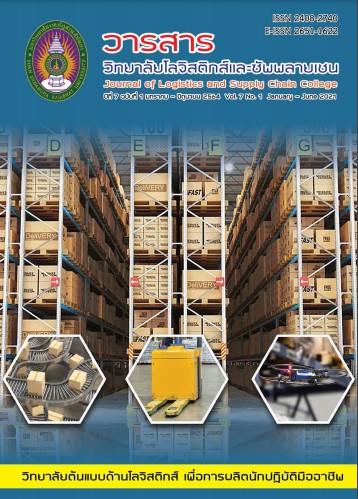The Redesign of the Point of Sales’ Electronic Equipment Distribution Network to Reduce the Distribution Cost: Case Study of ABC Co., Ltd.
Keywords:
Distribution Network, Vehicle Routing Problem, Point of Sales Systems, ScenarioAbstract
This research aims to reduce the distribution cost of the electronics device products for point of sale systems. It was found that at present, the case study company distributes products to a customer using the indirect distribution network where the regional warehouses are set as the intermediates. The company's distribution costs consist of two major costs: The regional warehouse rental cost of 1,660,548 baht and freight cost of 2,435,643 baht. The proportion of the regional warehouse rental cost is as high as 41% of the total distribution cost. Thus, the direct distribution network is introduced by the researcher to the company. Five simulation scenarios are used to test the efficiency of the new redesigned distribution network. Factors that are used as conditions in the simulation model are sales volume, distribution process, and distribution cost. The data is collected from 123 salespeople and warehousing staff. Vehicle Routing Problem using Saving Algorithm is applied in simulation case 2 – 5. For simulation case 1 and in case of the products which has been shipped to each salesperson are insufficient for sales in each month, products will be delivered individually to salesperson when needed. The sales data of salesperson in Bangkok area from February 2019 to January 2020 is used to in all scenarios. The simulation results show that the new distribution network causes higher freight costs in all simulation models compared to the current distribution network. However, it is able to eliminate the cost of warehouse rental in Bangkok by 696,000 baht per year. When considering the total distribution cost, it is found that all scenarios contribute lower total distribution cost compared to the current distribution cost occurred in the present, especially in the fourth and the fifth scenario can reduce the total distribution cost by 87.42 percent and 82.48 percent, respectively.
References
กฤษณา ปุณยางกูร, จรรยา ธนาอธิพร, ระวีวรรณ มาลัยวรรณ, ศรีธนา บุญญเศรษฐ์, จรรยา ฤกษ์ศิริสุข, ธีระ พุ่มเสนาะ, จักรกฤษณ์ ดวงพัสตรา, สิริอร เศรษฐมานิต และนันทิ สุทธิการนฤนัย. (2554) . เศรษฐศาสตร์ การจัดการขนส่งและโลจิสติกส์ (Economics of Transportation and Logistics Management). พิมพ์ครั้งที่ 1. นนทบุรี : สำนักพิมพ์มหาวิทยาลัยสุโขทัยธรรมธิราช.
ฉัตริกา สมรูป. (2557) . การศึกษารูปแบบการกระจายสินค้าเพื่อลดต้นทุนโลจิสติกส์กรณีบริษัท X.X.X. จำกัด. สาระนิพนธ์ปริญญามหาบัณฑิต กลุ่มวิชาการจัดการโลจิสิตกส์ , มหาวิทยาลัยหอการค้าไทย
ปรียาณัฐ เอี๊ยบศิริเมธี นันทิ สุทธิการนฤนัย และ สราวุธ จันทร์ผง. (2563) . เทคนิคการแก้ปัญหาการกระจายสินค้าและการขนส่ง.วารสารวิทยาลัยนครราชสีมา สาขามนุษย์ศาสตร์และสังคมศาสตร์, 14(1), 326–342
พิมพ์ชนก ทำนอง. (2552) . การจัดเส้นทางการขนส่งสินค้าจากจุดส่งเดียว กรณีเปรียบเทียบวิธีการแบบฮิวริสติกส์ และวิธีการเชิงพันธุกรรม. กรุงเทพมหานคร : มหาวิทยาลัยนเรศวร .
พิชญ์ พันธุ์พิพัฒน์ และ เปรมพร เขมาวุฆฒ์. (2562) . การจัดเส้นทางการขนส่งของรถบรรทุกขนาดใหญ่สำหรับสินค้าประเภทเทกองและกระสอบ กรณีศึกษาบริษัทผู้ให้บริการขนส่ง. วิศวกรรมสารเกษฒบัณฑิต, 9(1), 1-20 .
ศิวพร สุกสี และ ธาริณี มีเจริญ. (2562) . การลดต้นทุนการขนส่งโดยการประยุกต์ใช้ปัญหาการจัดเส้นทางการเดินรถ: กรณีศึกษา บริษัทจำหน่ายอุปกรณ์ประดับยนต์. วิศวกรรมสารเกษมบัณฑิต, 9(1), 69-84.
อัครพล ชุณหเกียรติ์สกุล. (2559). การลดต้นทุนการขนส่งของบริษัทขนส่ง กรณีศึกษาศูนย์กระจายสินค้าจังหวัดเพชรบุรี. สารนิพนธ์ปริญญาบริหารธุรกิจมหาบัณฑิต คณะพาณิชยศาสตร์และการบัญชี, มหาวิทยาลัยธรรมศาสตร์.
อสมาพร ประดุจมณีพันธ์ . (2552). การออกแบบและประเมินระบบการขนส่งสินค้าโดยตรงของสินค้าเคมีเหลวจากโรงกลั่นไปยังลูกค้า. วิทยานิพนธ์ปริญญาวิทยาศาสตร์มหาบัณฑิต, จุฬาลงกรณ์มหาวิทยาลัย.
Archetti, C., Bianchessi, N. and Speranza, M.G .(2015).A Branch-price-and-cut Algorithms for theCommodity Constrained Split Delivery Vehicle Routing Problem. Computers and Operations Research. 64,pp. 1-10.
Bolduc, M.C., Laporte, G., Renaud, J. andBoctor, F.F. (2010) .A Tabu Search Heuristic for the Split Delivery Vehicle Routing Problem with Production and Demand Calendars. European Journal of Operational Research, 202, pp. 122-130.
Chopra, S. (2003). Designing the Distribution Network in a Supply Chain. Transportation Research: Part E: Logistics and Transportation Review. Retrieved 25 December 2019 , From : http://dx.doi.org/10.1016/S1366-5545(02)00044-3.
Emmanouil E, Zachariadis, Chris T. Kiranoudis. (2012). An effective local search approach for the Vehicle Routing Problem with Backhauls. Expert Systems with Applications. 39(3) : 3174-3184.
Larry Snyder (online) . VRP solver is for Windows-based systems. Retrieved 20 March 2019, From:https://coral.ise.lehigh.edu/larry/software/vrp-solver/.
Silva, M.M., Subramanian, A. and Ochi, L.S. (2015) .An Iterated Local Search Heuristic for the Split Delivery Vehicle Routing Problem. Computers and Operations Research. 53, pp. 234-249.
Wilck IV, J.H. and Cavalier, T.M. (2012) .A Genetic Algorithm for the Split Delivery Vehicle Routing Problem. American Journal of Operations Research. 2, pp. 207-216.
Prat Boonsam, Nanthi Suthikarnnarunai and Wanchai Rattanawong. (2013) . Efficiency Improvement for Multi Depot Vehicle Routing: A Case Study in Cash Distribution. Applied Mechanics and Materials , 284-287: 3667-367



